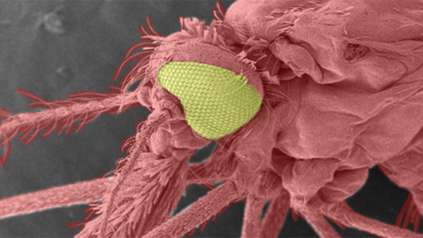Pocket-sized DNA sequencers track malaria drug resistance in near real-time
Scientists have developed a technique to rapidly and reliably detect genetic changes in malaria parasites in Ghana, using just a gaming laptop and portable MinION sequencer from Oxford Nanopore1.
Researchers from the Wellcome Sanger Institute and University of Ghana were able to demonstrate for the first time that end-to-end, real-time pathogen monitoring from clinical blood samples is possible in rural, resource-limited malaria hotspots. They looked for key drug resistance markers in the malaria parasite, and diversity in the vaccine target gene2.
The findings, published in Nature Microbiology (23 November), pave the way for local monitoring of drug resistance and evaluating new malaria vaccines in affected regions themselves.
Despite intensive control efforts in recent decades, malaria still kills over 600,000 people annually3, most of which are young children in sub-Saharan Africa. A key factor is the ability of malaria parasites to rapidly evolve resistance to antimalarial drugs and other medical interventions.
Genomic surveillance – the continuous monitoring of changes in the parasite’s DNA – provides the tools to analyse the genomic data behind parasite drug resistance. But until recently, it has mostly been carried out in distant labs in high-income, non-endemic countries, concentrating capacity away from affected regions.
In this new study, researchers set out to develop an accessible, near real-time method to monitor parasite mutations within the communities most affected by malaria.
Researchers employed standard molecular biology equipment for collecting parasites from blood spot samples, prepared by a simple finger prick. They then sequenced and analysed the malaria parasite DNA using the portable MinION device and a laptop computer to detect known drug resistance markers, emerging mutations, and targets of new malaria vaccines.
The team successfully carried out the study from two sites: an urban hospital in the Ghanaian capital Accra and a rural town 11-hours’ drive to the north. They were able to generate sequencing information in as little as 48 hours after receiving a sample, while keeping costs minimal, at around £27 per sample in batches of 96.
The team showed frontline treatments remain widely effective against local strains in Ghana currently4. However, ongoing monitoring is essential, including to protect high-risk groups that receive targeted interventions5.
They also discovered multiple genetic differences between circulating malaria strains and the protein targeted by newly recommended malaria vaccines. While requiring further study, these could impact the latest vaccine rollouts across Africa.
“By taking sequencing to the source, insights arrive in days rather than years — enabling rapid, localised responses. This unprecedented speed promises to be a powerful game-changer against infectious diseases outpacing our countermeasures. We hope this on-site approach is soon applied here to other pathogens.”
Edem Adika,co-first author of the study at University of Ghana
“The repeated evolution and spread of resistance to key antimalarial drugs has thwarted efforts to eliminate malaria over the last 70 years. Expanding molecular surveillance in Africa is now critical for tracking emerging drug and diagnostic test resistance, and informing interventions like new vaccines.”
Dr William Hamilton, senior author of the study at the Wellcome Sanger Institute
“This sequencing workflow has tremendous potential for addressing the sequencing gap in sub-Saharan Africa given its lower cost and ease-of-use. But scaling capacity sustainably requires expanding local training programs, bioinformatics infrastructure, and data science expertise. These should be priorities for the global pathogen genomics community going forward.”
Dr Lucas Amenga-Etego, senior author of the study at the West African Centre for Cell Biology of Infectious Pathogens (WACCBIP), University of Ghana
More information
Publication
S.T. Girgis et al. (2023) Drug resistance and vaccine target surveillance of Plasmodium falciparum using nanopore sequencing in Ghana. Nature Microbiology. DOI: 10.1038/s41564-023-01516-6
Footnotes
- The Oxford Nanopore MinION is a portable, pocket-sized DNA sequencer that utilises nanopore sequencing technology to analyse genetic material. This technology offers advantages such as long-read sequencing and direct detection of genetic changes.
- The assay designed for this procedure tested parasite samples using a multiplex polymerase chain reaction (PCR), looking at five key markers in the DNA associated with changes that provided drug resistance, as well as the leading vaccine and monoclonal antibody target, circumsporozoite protein (csp). csp helps parasites to establish infection early on after injection by feeding mosquitoes, so blocking csp helps to prevent malaria infections.
- The team did not find evidence of resistance to artemisinins – the current front-line and best treatment for P. falciparum. Partial resistance to artemisinins has been detected in southeast Asia and eastern Africa. Ongoing monitoring for resistance will be essential.
- Although mutations associated with resistance to the antimalarial drugs sulfadoxine and pyrimethamine (SP) were found, the especially dangerous mutations causing ‘high-level’ resistance to SP were not found. This is reassuring, because SP is used for prophylaxis in young children and during pregnancy in Ghana.





